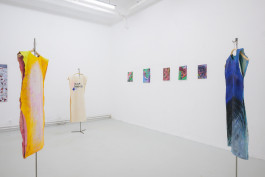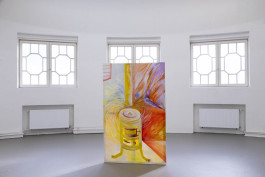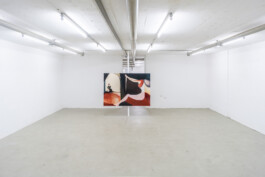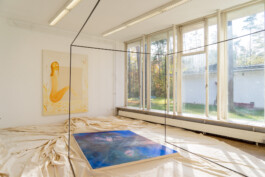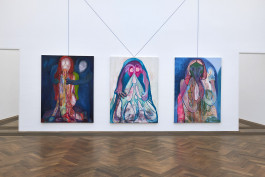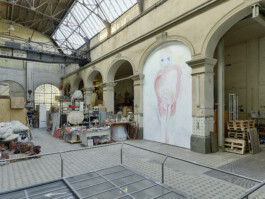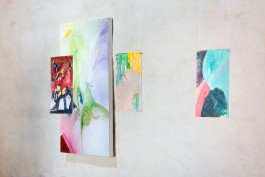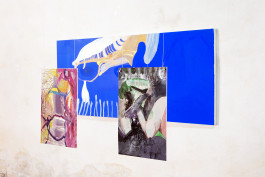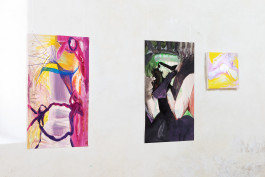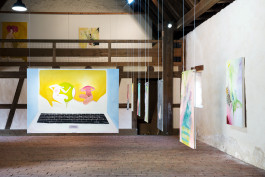(the struggle for) a title and how long it will last, 2021
Mixed media on cotton, 140 × 200 cm
Slip of the Brush, 2022
Oil on cotton, 150 × 95 cm
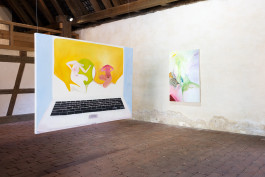
Untitled, 2021
Oil on paper, 29.7 × 21 cm
Blue, 2020
Mixed media on cotton, 100 × 250 cm

Untitled, 2021
Oil on paper, 29.7 × 21 cm
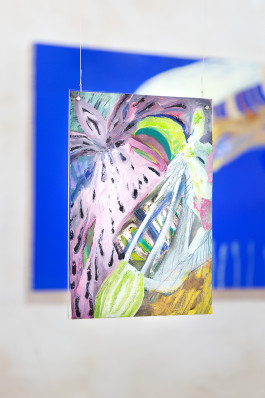
Reverse Separation, 2021
Mixed media on cotton, 30 × 40 cm
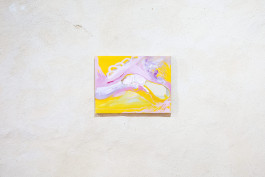
Exhibition view Ungehalten, Merdinger Kunstforum, 2022
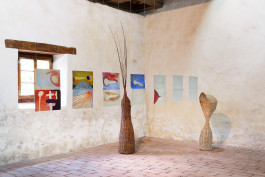
Entwürfe ohne Namen, 2020 (series with seven sheets)
Mixed media on paper, each 42 × 29.7 cm
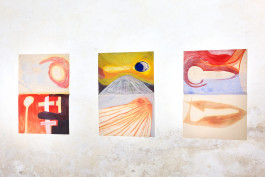
Ohne Name (kopflose Figur), 2021
Willow, 290 × 31 × 36 cm
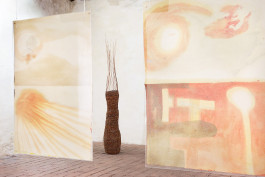
Ohne Name, 2021
Pelled willow, 127 × 53 × 26 cm
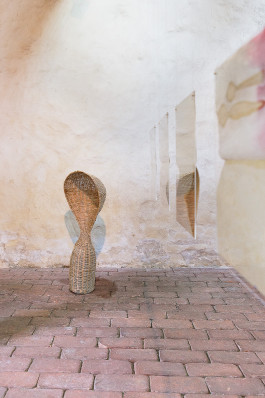
Exhibition view Ungehalten, Merdinger Kunstforum, 2022
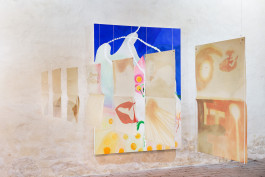
Unfassbar werden, 2021
Mixed media on cotton, 210 × 160 cm
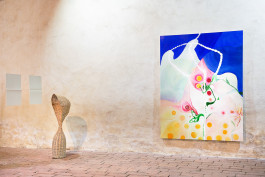
Untitled a, 2020 (series with three sheets)
Oil on paper, 42 × 29.7 cm
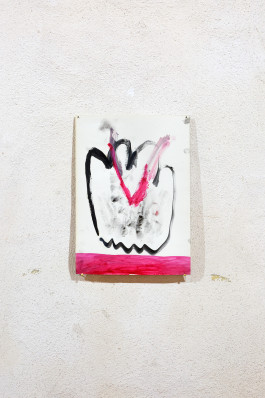
Untitled b, 2020 (series with three sheets)
Oil on paper, 42 × 29.7 cm

Untitled c, 2020 (series with three sheets)
oil on paper, 42 × 29.7 cm

Ungehalten,
Merdinger Kunstforum, 2022
UNGEHALTEN
Alex Hojenski
Ungehalten [German adjective ranging in meaning from unrestrained to disgruntled] suggests indignation, an anger that spreads unabated. However, you can also let yourself fall ungehalten, uninhibitedly. To be unbound, open.
Ungehalten brings together oil paintings on paper and canvas, as well as hand-woven basket objects created within the last two years. Taking the central role of the sketch as a starting point in Mirjam's work, various groups of works come together, following up on the paper works.
Suspended freely in the room, the front and back sides of the sheets are visible, some of which are heavily loaded with oil paint. A presentation that reverses the principle of a classical framing. Reinforced by their plexiglass backing, the papers remain open instead of being locked in by glass and an outlining frame – securely stored, contained.
The back-side speaks of the beginning, the front tells the conclusion of the many overlapping painting stages through which the motifs took shape. The seeping edges and alternative formations on the back-side are documents of the momentum intrinsic to the colors and pigments, which do not spare the underlying layers of paint of being soaked and devoured, as they make their way through the material.
These small-format paper works are part of a continuous studio practice. They’re recipients of residual paints, being coated and replenished over and over again. Accompanying the process of creating larger formats, there is often a kinship in color compositions or markings between the canvases and sketch sheets.
Here, divisions are to be loosened up. As you’re making your rounds throughout the paintings and look more closely, you’ll encounter complex constellations in many a small sheet, transcending mere quick sketches.
The sketch has carte blanche to forgo any claim – aside from its claim to be a sketch. It is a classic finger exercise and collection of ideas. As a preliminary stage, allegedly showing something immature, but more rather depicting something non-predefined, it is fascinatingly magical and, at the same time, unpretentious. The flexibility of a non-predefined appearance offers the possibility of transformation. An existence based on becoming breaks away from a fixed definition of being, in which duties and participations seem to be already assigned at birth.
Until a work is completed, there are still open questions between it and Mirjam. Sometimes, after enough time spent together, it turns out that this question is the objective of this painting and that they’re asking it together.
There’s a song stuck in my head addressing the axolotl as a being full of potency. As something that has not decided on either evolutionary direction, something that in its non-specification maintains an intermediate form, combining the possibilities of other life forms within itself. The axolotl is a species of salamander mostly found in Mexico, which occurs naturally as a so-called permanent larva. This means that, unlike most amphibians, it doesn’t undergo metamorphosis, nor do its gills re-evolve to transform into a land creature. Spending its entire life under water, it never changes its appearance. However, axolotls have the ability to restore limbs and organs, even parts of their heart and brain.
Totipotent, the lyrics add: Still undetermined in differentiation.
Its greatest potential seems to be refusal.
In Mirjam Walter's work, too, everything is far from being cooperative. Over and again, there are breaks, areas in the paintings that are evasive or appear to be working against each other. Exclusion and demarcation. "To be left out" in a group, just like "being all at sea”, quite singular. Dying as the loss of frame and form. Losing others and yourself.
And yet, a possibility for miracles. Moments of fertility and mutual complement.
Mirjam leads a discussion about form. Or rather, in her discussion she’s guided by forms. What can be bundled in a form? What wants to be? What is a flexible form in a fixating medium? One that moves alongside and along with the viewer?
The production of undefined scenes, negotiating between abstraction and figuration, is this a possible approach to avoid representation?
The crux of said representation is that, in efforts to convey criticism and doubts, it tends to repeat the very thing it wants to abolish.
The title of the exhibition, too, relates to the negotiation between abstraction and figuration, which I would argue, is not a purely specific one to painting.
Ungehalten would be on a spectrum. Abstraction to the one side, which for Mirjam works without content, and figuration to the other side, as something that captures an object.
For me, it’s central that Mirjam's visual language works with lively forms that can be both: abstract and figurative. It all has an inherent activity that is vibrant and often communicating emotionally.
In Unfassbar werden [Becoming inconceivable] there are leaves, pollen, pores, fruits, buds, beaks and fingers lining up around a white construct of pearl string, spine, fish bones and branches.
It’s exciting to "recognize" elements, to assign something familiar onto them, to approach the image in the translation of details. Nevertheless, I feel that to encounter its content, I neither want nor need to decipher the festive tangles in front of these bulging, wafting surfaces. Probably quite the opposite.
Mirjam's works are closely linked to life. Some paintings show people or something human, they tell of experiences or dreams. The body as a very stretchable form opens up and closes, is wounded, loved and dissolved.
Bundled with a thin, blue ribbon, a figure is formed by its demarcation. Its content – whether fleshy volume or surging air – remains a mystery.
The observation that people can be divided, by their nature and behavior, into spoon, fork and knife people (including interim stages and hybrid forms) led Mirjam to a series of drawings and woven objects.
The "Nameless” objects (not without title) have no heads. They're not a concrete personification. They’re open to the top.
Many of the works have something delicious to them. The more time I spend with them, the more clearly I see a high. Ecstatic areas and swirls, outgrowths and pores that bump into, surround, swarm, explore, sense each other. First delicious, then repulsive. Then both.
Layering, infiltrating, one form taking over the other. The negotiation of the self by means of demarcation to the environment, therein too lies the corporeal. In a boundary, a frame that can be flexible and stretchable, permeable and breathable, but still represents a fusion.
Bodies are always full of other bodies, we are shells and also surrounded by shells. This applies to vital microorganisms in our bodies, as well as to people, environments and places that shape and accompany us. We spread out, are fragmented, open-pored.
The open spots are sensitive. They're junctures, not necessarily weak, but highly reactive and alert.
